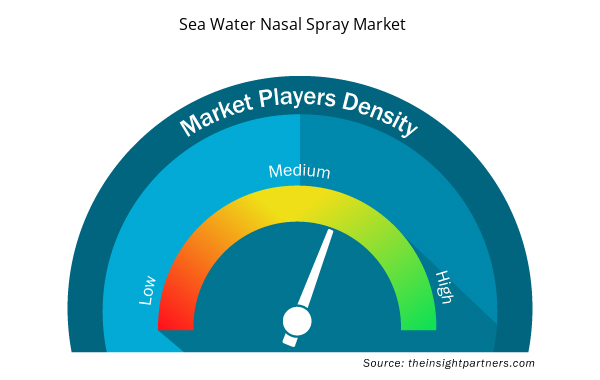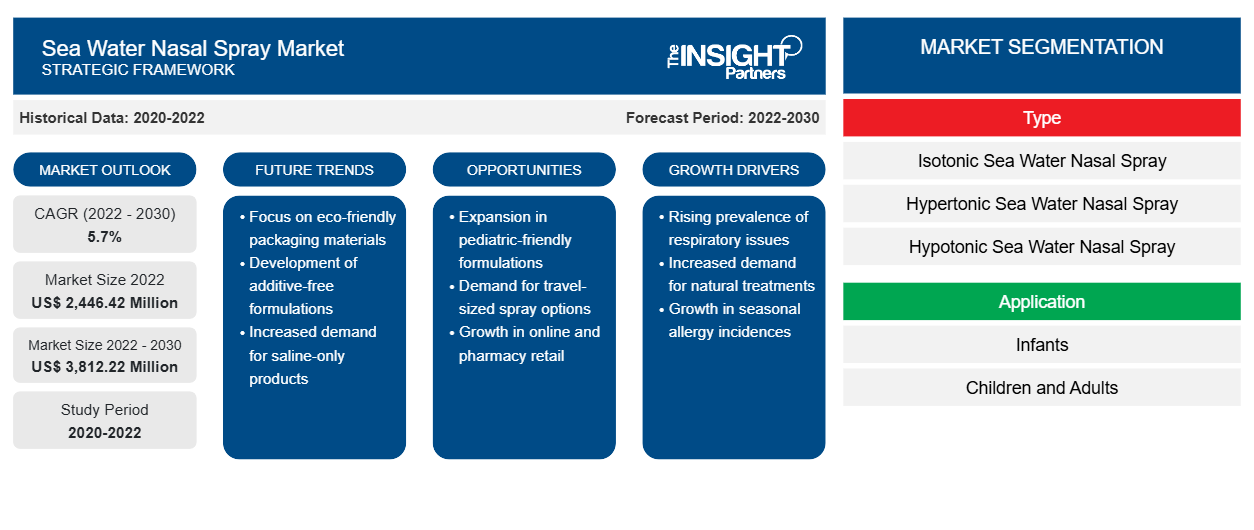[研究报告] 海水鼻喷雾剂市场规模预计将从 2022 年的 24.4642 亿美元增长到 2030 年的 38.1222 亿美元;预计 2022-2030 年期间的复合年增长率为 5.7%。
市场洞察和分析师观点:
鼻喷雾剂有助于将药物通过鼻腔输送到鼻腔中,以治疗过敏症和其他与脑炎、糖尿病、牙齿问题和中枢神经系统有关的问题。过敏是人体免疫系统对外来物质产生异常反应的一种情况。鼻喷雾剂药物产品由治疗活性成分或药物物质组成,形式为赋形剂的溶液或悬浮液。
增长动力:
过敏是一种削弱免疫系统的疾病,免疫系统对外来物质产生异常反应。过敏有多种形式,例如过敏性鼻炎 (AR),这影响了美国近 4000 万至 5000 万人。一些过敏可能会干扰日常活动和生活质量。由于人口增加,城市化和工业化进程大大加快,导致过敏原增加。这些过敏原是许多人过敏或传染病的罪魁祸首。呼吸道过敏包括过敏性哮喘和鼻炎,它们有许多共同的特征,并且经常与空气污染和花粉有关。过敏症是美国儿童最常见的健康问题之一。在美国,每年预计有 90,000 人因食物过敏而去急诊室就诊。2021 年,美国约有 8100 万人被诊断出患有花粉症(季节性过敏性鼻炎)。这相当于近 26%(6700 万)的成年人和 19%(1400 万)的儿童。预计海水鼻喷雾剂市场将以高复合年增长率增长
根据美国国立卫生研究院关于哮喘的文章,哮喘和过敏性疾病(如湿疹、食物过敏和过敏性鼻炎(花粉症))在美国所有年龄段都很常见。哮喘影响了美国超过 2400 万人,其中包括超过 600 万儿童。此外,根据美国疾病控制与预防中心的 FactStats - 过敏和花粉症,过敏是美国第六大慢性病原因,2021 年每年的费用超过 180 亿美元。
欧洲过敏和免疫学协会指出,过敏是欧洲最常见的慢性疾病之一。目前,欧洲有 1.5 亿人患有过敏症,预计到 2025 年,欧洲 50% 的人口将患有某种过敏症。
英国也不例外,英国的过敏症发病率非常高,高达44%的英国成年人患有过敏症,近一半的人患有不止一种过敏症,这使英国成为全球最“过敏”的国家之一。
因此,过敏性鼻炎等过敏性疾病的患病率上升增加了对鼻腔喷雾剂的需求,预计这将推动海水鼻腔喷雾剂市场预测。
定制此报告以满足您的需求
您可以免费定制任何报告,包括本报告的部分内容、国家级分析、Excel 数据包,以及为初创企业和大学提供优惠和折扣
- 获取此报告的关键市场趋势。这个免费样品将包括数据分析,从市场趋势到估计和预测。
报告细分和范围:
海水鼻喷雾剂市场报告根据类型、应用、分销渠道和地理位置进行分类。就类型而言,海水鼻喷雾剂市场分为等渗海水鼻喷雾剂、高渗海水鼻喷雾剂和低渗海水鼻喷雾剂。根据应用,海水鼻喷雾剂市场分为婴儿、儿童和成人。就分销渠道而言,海水鼻喷雾剂市场增长分为医院药房、药店和零售药店、网上药店。根据地域,市场细分为北美(美国、加拿大和墨西哥)、欧洲(法国、德国、英国、西班牙、意大利和欧洲其他地区)、亚太地区(中国、印度、日本、澳大利亚、韩国和亚太地区其他地区)、中东和非洲(沙特阿拉伯、阿联酋、南非和中东和非洲其他地区)以及南美洲和中美洲(巴西、阿根廷和南美洲和中美洲其他地区)。
节段分析:
根据类型,海水鼻喷雾剂市场分析分为等渗海水鼻喷雾剂、高渗海水鼻喷雾剂和低渗海水鼻喷雾剂。2022 年,高渗海水鼻喷雾剂占据了最大的市场份额,预计在 2022 年至 2030 年期间将实现最高的复合年增长率。医生推荐使用高渗鼻喷雾剂,因为其盐浓度较高,可以更有效地吸出液体和粘液。
根据应用,海水鼻喷雾剂市场预测分为婴儿、儿童和成人。儿童和成人细分市场在 2022 年占据了最大的市场份额,预计在 2022 年至 2030 年期间将实现最高的复合年增长率。
根据分销渠道,海水鼻喷雾剂市场份额分为医院药房、药店和零售药店、网上药店。医院药房部分在 2022 年占据海水鼻喷雾剂市场份额最大,预计 2022 年至 2030 年的复合年增长率最高
区域分析:
海水鼻喷雾剂市场分析主要分为北美、欧洲、亚太地区、南美和中美以及中东和非洲。北美在 2022 年占据了大部分市场份额,其次是欧洲。根据 EUFOREA(欧洲过敏和呼吸道疾病研究与教育论坛)的数据,欧洲约 10% 的人口患有慢性(鼻)鼻窦炎。这大致相当于西班牙的人口。
根据爱尔兰过敏协会的说法,过敏性鼻炎是一种全球性常见疾病。全球至少有 4 亿人患有过敏性鼻炎,欧洲的发病率在 17% 至 29% 之间。在爱尔兰,过敏性鼻炎的发病率约为 26%,这与英国的研究结果一致。
海水鼻腔喷雾剂市场区域洞察
Insight Partners 的分析师已详细解释了预测期内影响海水鼻喷雾剂市场的区域趋势和因素。本节还讨论了北美、欧洲、亚太地区、中东和非洲以及南美和中美洲的海水鼻喷雾剂市场细分和地理位置。

- 获取海水鼻喷雾剂市场的区域特定数据
海水鼻喷雾剂市场报告范围
| 报告属性 | 细节 |
|---|---|
| 2022 年市场规模 | 24.4642亿美元 |
| 2030 年的市场规模 | 38.1222亿美元 |
| 全球复合年增长率(2022 - 2030 年) | 5.7% |
| 史料 | 2020-2022 |
| 预测期 | 2022-2030 |
| 涵盖的领域 | 按类型
|
| 覆盖地区和国家 | 北美
|
| 市场领导者和主要公司简介 |
|
海水鼻喷雾剂市场参与者密度:了解其对业务动态的影响
海水鼻喷雾剂市场正在快速增长,这得益于终端用户需求的不断增长,而这些需求又源于消费者偏好的不断变化、技术进步以及对产品优势的认识不断提高等因素。随着需求的增加,企业正在扩大其产品范围,进行创新以满足消费者的需求,并利用新兴趋势,从而进一步推动市场增长。
市场参与者密度是指在特定市场或行业内运营的企业或公司的分布情况。它表明在给定市场空间中,相对于其规模或总市场价值,有多少竞争对手(市场参与者)存在。
在海水鼻喷雾剂市场运营的主要公司有:
- 斯特里玛
- 海蓝之谜实验室
- 杰罗利马托斯国际公司
- 休默尔
- 吉弗雷尔
免责声明:上面列出的公司没有按照任何特定顺序排列。

- 了解海水鼻喷雾剂市场顶级关键参与者概况
行业发展和未来机遇:
- 2023 年 1 月,Viatris Inc. 宣布已完成对 Oyster Point Pharma 和 Famy Life Sciences 的收购,以建立新的 Viatris 眼科护理部门。此次收购将有助于该公司的业务扩张。
- 2023 年 3 月,Teva Pharmaceuticals 在美国推出了 2.5 毫克和 20 毫克两种规格的 Revlimid(来那度胺胶囊)仿制药。该产品的推出将有助于该公司扩大其产品组合。
竞争格局和重点公司:
Sterimar、LABORATOIRE DE LA MER、Gerolymatos International、Humer、Gifrer、GSK、Nacur Healthcare、Laboratoires Pharmaster、Bayer 和 Sandoz 是海水鼻喷雾剂市场前 10 名公司。这些公司专注于推出新的高科技产品、现有产品的技术进步以及地域扩张,以满足全球日益增长的消费者需求。
- 历史分析(2 年)、基准年、预测(7 年)及复合年增长率
- PEST 和 SWOT 分析
- 市场规模价值/数量 - 全球、区域、国家
- 行业和竞争格局
- Excel 数据集


- Health Economics and Outcome Research (HEOR) Services Market
- Real-Time Location Systems Market
- Airline Ancillary Services Market
- Social Employee Recognition System Market
- Fixed-Base Operator Market
- Nuclear Waste Management System Market
- Semiconductor Metrology and Inspection Market
- Industrial Valves Market
- Architecture Software Market
- Genetic Testing Services Market

Report Coverage
Revenue forecast, Company Analysis, Industry landscape, Growth factors, and Trends

Segment Covered
This text is related
to segments covered.

Regional Scope
North America, Europe, Asia Pacific, Middle East & Africa, South & Central America

Country Scope
This text is related
to country scope.
常见问题
Nasal sprays help deliver the drug through the nose in the nasal cavity to treat allergies and other problems related to brain inflammation, diabetes, dental problems, and the central nervous system. Allergy is a condition in which the body's immune system reacts abnormally to a foreign substance. Nasal spray drug products consist of therapeutically active ingredients or drug substances in the form of solution or suspension of excipients.
The factors driving the market include increase in infection and allergic cases and a rise in patient preference for nasal drug delivery due to easy administration and better efficacy. However, regulatory hurdles restrain the market growth.
The global sea water nasal spray, by type, is segmented into isotonic sea water nasal spray, hypertonic sea water nasal spray, and hypotonic sea water nasal spray. In 2022, the hypertonic sea water nasal spray segment held the largest share of the market and is anticipated to register the highest CAGR in the market from 2022 to 2030.
The global sea water nasal spray majorly consists of the players such as Sterimar, LABORATOIRE DE LA MER, Gerolymatos International, Humer, Gifrer, GSK, Nacur Healthcare, Laboratoires Pharmaster, Bayer, and Sandoz
Trends and growth analysis reports related to Life Sciences : READ MORE..
The List of Companies - Sea Water Nasal Spray Market
- Sterimar
- LABORATOIRE DE LA MER
- Gerolymatos International
- Humer
- Gifrer
- GSK
- Nacur Healthcare
- Laboratoires Pharmaster
- Bayer
- Sandoz
The Insight Partners performs research in 4 major stages: Data Collection & Secondary Research, Primary Research, Data Analysis and Data Triangulation & Final Review.
- Data Collection and Secondary Research:
As a market research and consulting firm operating from a decade, we have published and advised several client across the globe. First step for any study will start with an assessment of currently available data and insights from existing reports. Further, historical and current market information is collected from Investor Presentations, Annual Reports, SEC Filings, etc., and other information related to company’s performance and market positioning are gathered from Paid Databases (Factiva, Hoovers, and Reuters) and various other publications available in public domain.
Several associations trade associates, technical forums, institutes, societies and organization are accessed to gain technical as well as market related insights through their publications such as research papers, blogs and press releases related to the studies are referred to get cues about the market. Further, white papers, journals, magazines, and other news articles published in last 3 years are scrutinized and analyzed to understand the current market trends.
- Primary Research:
The primarily interview analysis comprise of data obtained from industry participants interview and answers to survey questions gathered by in-house primary team.
For primary research, interviews are conducted with industry experts/CEOs/Marketing Managers/VPs/Subject Matter Experts from both demand and supply side to get a 360-degree view of the market. The primary team conducts several interviews based on the complexity of the markets to understand the various market trends and dynamics which makes research more credible and precise.
A typical research interview fulfils the following functions:
- Provides first-hand information on the market size, market trends, growth trends, competitive landscape, and outlook
- Validates and strengthens in-house secondary research findings
- Develops the analysis team’s expertise and market understanding
Primary research involves email interactions and telephone interviews for each market, category, segment, and sub-segment across geographies. The participants who typically take part in such a process include, but are not limited to:
- Industry participants: VPs, business development managers, market intelligence managers and national sales managers
- Outside experts: Valuation experts, research analysts and key opinion leaders specializing in the electronics and semiconductor industry.
Below is the breakup of our primary respondents by company, designation, and region:

Once we receive the confirmation from primary research sources or primary respondents, we finalize the base year market estimation and forecast the data as per the macroeconomic and microeconomic factors assessed during data collection.
- Data Analysis:
Once data is validated through both secondary as well as primary respondents, we finalize the market estimations by hypothesis formulation and factor analysis at regional and country level.
- Macro-Economic Factor Analysis:
We analyse macroeconomic indicators such the gross domestic product (GDP), increase in the demand for goods and services across industries, technological advancement, regional economic growth, governmental policies, the influence of COVID-19, PEST analysis, and other aspects. This analysis aids in setting benchmarks for various nations/regions and approximating market splits. Additionally, the general trend of the aforementioned components aid in determining the market's development possibilities.
- Country Level Data:
Various factors that are especially aligned to the country are taken into account to determine the market size for a certain area and country, including the presence of vendors, such as headquarters and offices, the country's GDP, demand patterns, and industry growth. To comprehend the market dynamics for the nation, a number of growth variables, inhibitors, application areas, and current market trends are researched. The aforementioned elements aid in determining the country's overall market's growth potential.
- Company Profile:
The “Table of Contents” is formulated by listing and analyzing more than 25 - 30 companies operating in the market ecosystem across geographies. However, we profile only 10 companies as a standard practice in our syndicate reports. These 10 companies comprise leading, emerging, and regional players. Nonetheless, our analysis is not restricted to the 10 listed companies, we also analyze other companies present in the market to develop a holistic view and understand the prevailing trends. The “Company Profiles” section in the report covers key facts, business description, products & services, financial information, SWOT analysis, and key developments. The financial information presented is extracted from the annual reports and official documents of the publicly listed companies. Upon collecting the information for the sections of respective companies, we verify them via various primary sources and then compile the data in respective company profiles. The company level information helps us in deriving the base number as well as in forecasting the market size.
- Developing Base Number:
Aggregation of sales statistics (2020-2022) and macro-economic factor, and other secondary and primary research insights are utilized to arrive at base number and related market shares for 2022. The data gaps are identified in this step and relevant market data is analyzed, collected from paid primary interviews or databases. On finalizing the base year market size, forecasts are developed on the basis of macro-economic, industry and market growth factors and company level analysis.
- Data Triangulation and Final Review:
The market findings and base year market size calculations are validated from supply as well as demand side. Demand side validations are based on macro-economic factor analysis and benchmarks for respective regions and countries. In case of supply side validations, revenues of major companies are estimated (in case not available) based on industry benchmark, approximate number of employees, product portfolio, and primary interviews revenues are gathered. Further revenue from target product/service segment is assessed to avoid overshooting of market statistics. In case of heavy deviations between supply and demand side values, all thes steps are repeated to achieve synchronization.
We follow an iterative model, wherein we share our research findings with Subject Matter Experts (SME’s) and Key Opinion Leaders (KOLs) until consensus view of the market is not formulated – this model negates any drastic deviation in the opinions of experts. Only validated and universally acceptable research findings are quoted in our reports.
We have important check points that we use to validate our research findings – which we call – data triangulation, where we validate the information, we generate from secondary sources with primary interviews and then we re-validate with our internal data bases and Subject matter experts. This comprehensive model enables us to deliver high quality, reliable data in shortest possible time.


 获取此报告的免费样本
获取此报告的免费样本